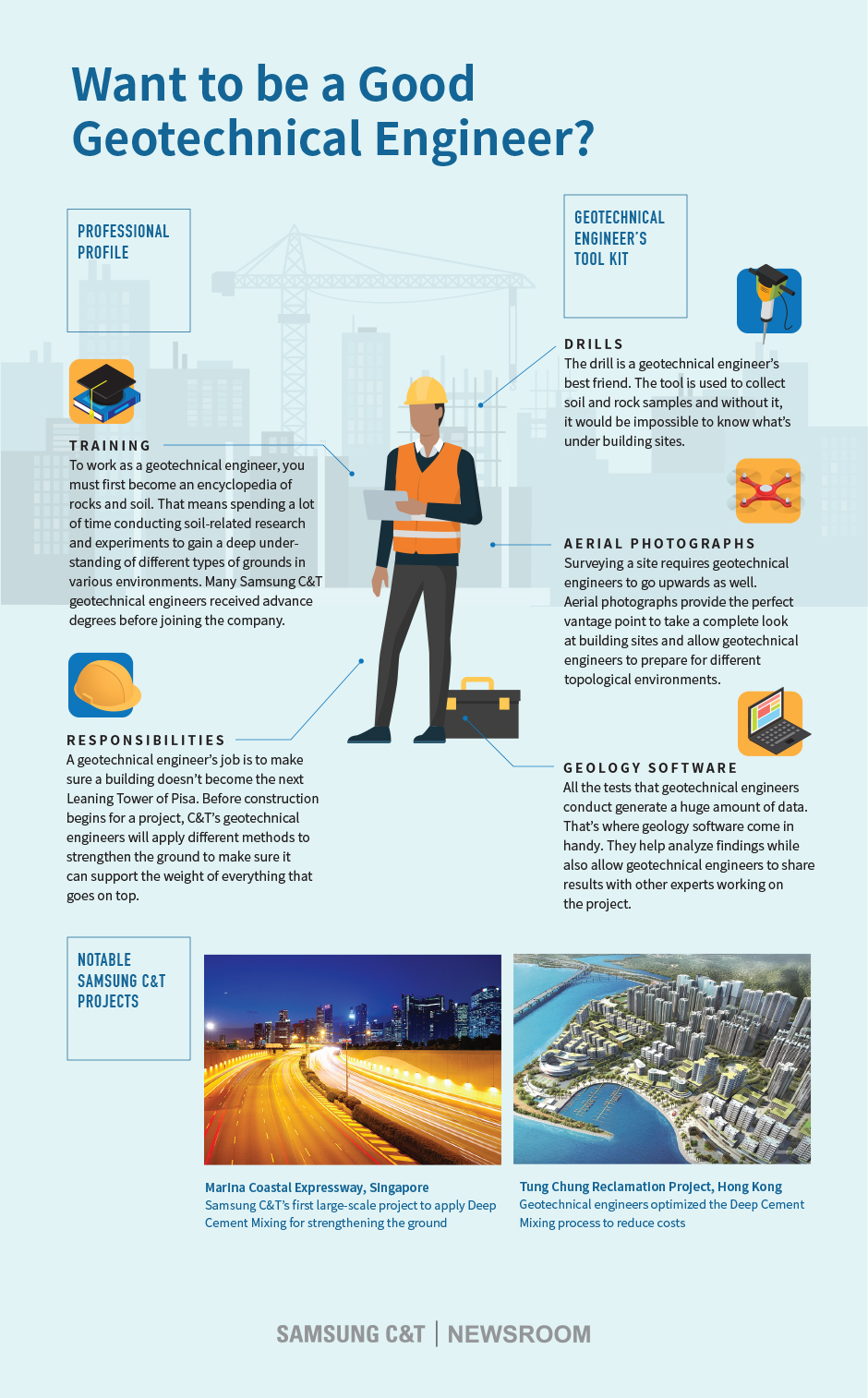The Only Guide for Geotheta
The Only Guide for Geotheta
Blog Article
Getting My Geotheta To Work
Table of ContentsGeotheta Fundamentals ExplainedThe Ultimate Guide To GeothetaGetting The Geotheta To WorkThings about GeothetaThe Of Geotheta

They carry out website investigations, collect samples, perform lab tests, and assess data to evaluate the viability of the ground for building tasks - Consulting Engineer. Based upon their searchings for, geotechnical designers give recommendations for structure style, incline stability, maintaining structures, and reduction of geotechnical risks. They team up with other professionals, such as architects, structural engineers, and construction groups, to make certain that geotechnical factors to consider are incorporated right into the general job style and implementation
By examining the habits and residential or commercial properties of soil and rock, they can identify potential geotechnical hazards such as landslides, dirt negotiation, or slope instability. Their expertise aids stop failures or accidents that could jeopardize lives and building. Below are some in-depth responsibilities and responsibilities of a geotechnical engineer: Website Investigation: Geotechnical engineers conduct website examinations to gather information on subsurface problems.
They analyze the data to comprehend the properties and behavior of the dirt and rock, including their toughness, leaks in the structure, compaction features, and groundwater problems. Geotechnical Analysis and Design: Geotechnical designers assess the information gathered during site examinations to analyze the security and suitability of the site for building and construction jobs. They do geotechnical calculations and modeling to evaluate factors such as birthing capacity, settlement, slope stability, lateral earth pressures, and groundwater circulation.
Facts About Geotheta Uncovered
Foundation Design: Geotechnical designers play an important function in creating foundations that can securely support the designated structure. They examine the dirt problems and tons demands to determine the ideal foundation type, such as shallow structures (e.g., footings), deep foundations (e.g (https://forums.hostsearch.com/member.php?265240-geotheta)., stacks), or specialized techniques like dirt renovation. They consider aspects such as negotiation limits, birthing capability, and soil-structure interaction to develop optimum foundation designs
They review building and construction plans, monitor website activities, and conduct field evaluations to verify that the design referrals are complied with. If unforeseen geotechnical concerns develop, they analyze the scenario and offer suggestions for removal or changes to the style. Risk Evaluation and Reduction: Geotechnical designers examine geotechnical risks and dangers related to the job site, such as landslides, liquefaction, or soil disintegration.

Cooperation and Interaction: Geotechnical engineers work carefully with other experts associated with a task, such as engineers, structural designers, and construction groups. Effective communication and partnership are essential to integrate geotechnical considerations into the general task style and building and construction procedure. Geotechnical engineers provide technological proficiency, response inquiries, and ensure that geotechnical needs are fulfilled.
Little Known Facts About Geotheta.
Below are some sorts of geotechnical engineers: Structure Engineer: Foundation designers concentrate on creating and examining structures for frameworks. They analyze the soil problems, load demands, and website qualities to identify one of the most suitable structure type and layout, such as shallow foundations, deep structures, or specialized strategies like pile structures.
They review the aspects influencing incline security, such as soil residential properties, groundwater problems, and incline geometry, and establish methods to protect against slope failings and alleviate risks. Earthquake Engineer: Quake designers concentrate on analyzing and creating structures to withstand seismic forces. They evaluate the he said seismic hazard of a site, review dirt liquefaction possibility, and create seismic style requirements to guarantee the safety and strength of structures during earthquakes.
They do area testing, accumulate samples, and analyze the collected data to identify the soil buildings, geologic developments, and groundwater problems at a site. Geotechnical Instrumentation Engineer: Geotechnical instrumentation designers concentrate on tracking and measuring the actions of dirt, rock, and structures. They install and preserve instrumentation systems that monitor variables such as dirt settlement, groundwater levels, slope activities, and architectural displacements to assess performance and supply very early cautions of potential concerns.
The Geotheta PDFs
They conduct tests such as triaxial examinations, consolidation examinations, straight shear tests, and permeability examinations to collect data for geotechnical analysis and layout. Geosynthetics Designer: Geosynthetics engineers focus on the style and application of geosynthetic materials, such as geotextiles, geogrids, and geomembranes. They make use of these materials to boost soil security, strengthen inclines, give drain options, and control erosion.
They tend to be investigatory people, which implies they're intellectual, introspective, and inquisitive. They are interested, systematic, sensible, logical, and logical. Some of them are also social, meaning they're kind, charitable, participating, client, caring, valuable, compassionate, skillful, and pleasant - Tailings Engineer.
In the office atmosphere, geotechnical designers make use of specialized software devices to carry out calculations, develop layouts, and evaluate information. They prepare records, testimonial job specifications, communicate with clients and team members, and coordinate task tasks. The workplace setup offers a helpful atmosphere for study, evaluation, and partnership with other specialists involved in the job.
The 25-Second Trick For Geotheta
They regularly check out task sites to perform site investigations, examine geotechnical problems, and gather information for evaluation. These sees include traveling to various areas, in some cases in remote or difficult terrains. Geotechnical designers may perform soil tasting, conduct examinations, and display construction activities to guarantee that the geotechnical aspects of the task are being applied properly.
Geotechnical engineers likewise function in specialized geotechnical laboratories. In these facilities, they perform experiments, carry out tests on soil and rock samples, and analyze the engineering buildings of the products. Geotechnical research laboratory designers function thoroughly in these settings, taking care of screening equipment, operating tools, and taping information. They collaborate with various other lab staff to ensure precise and trustworthy screening outcomes.
Report this page